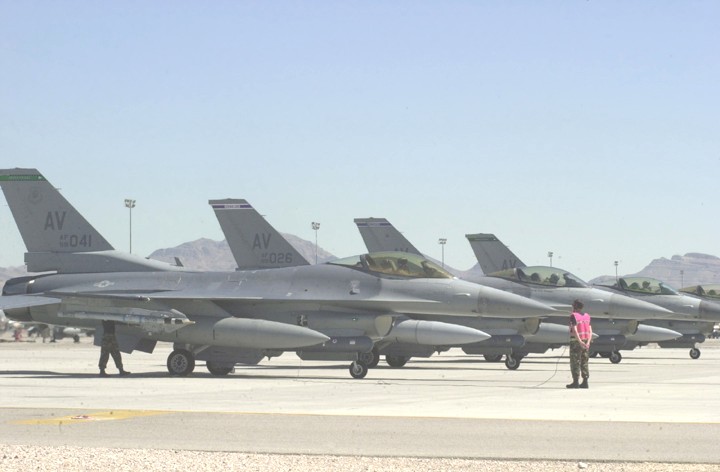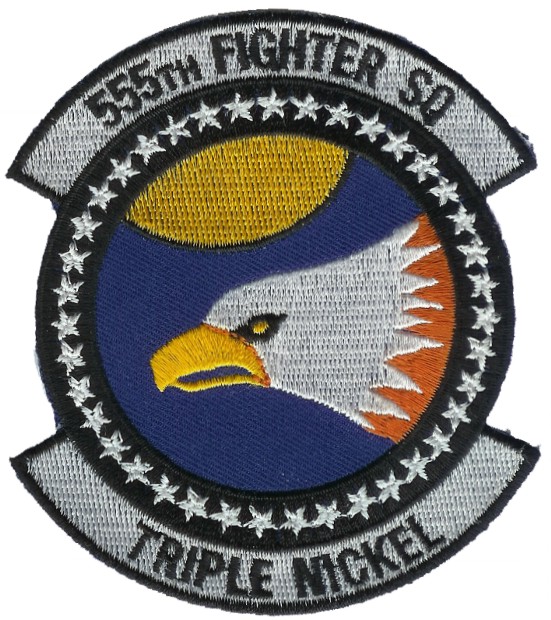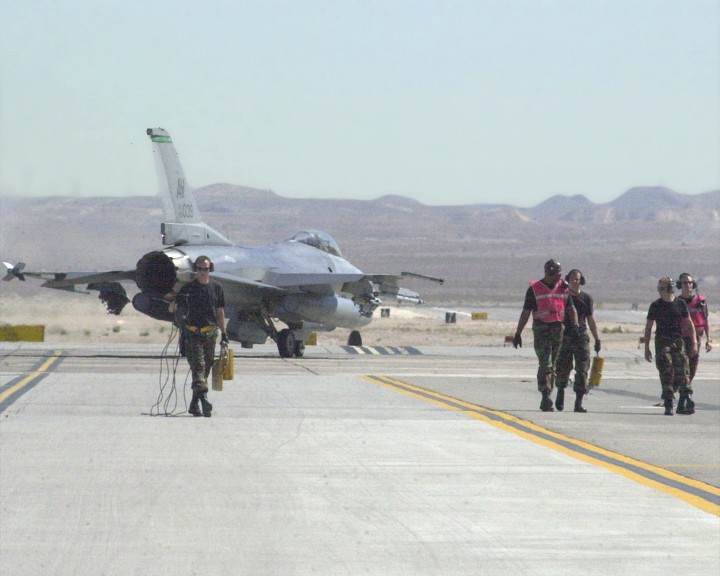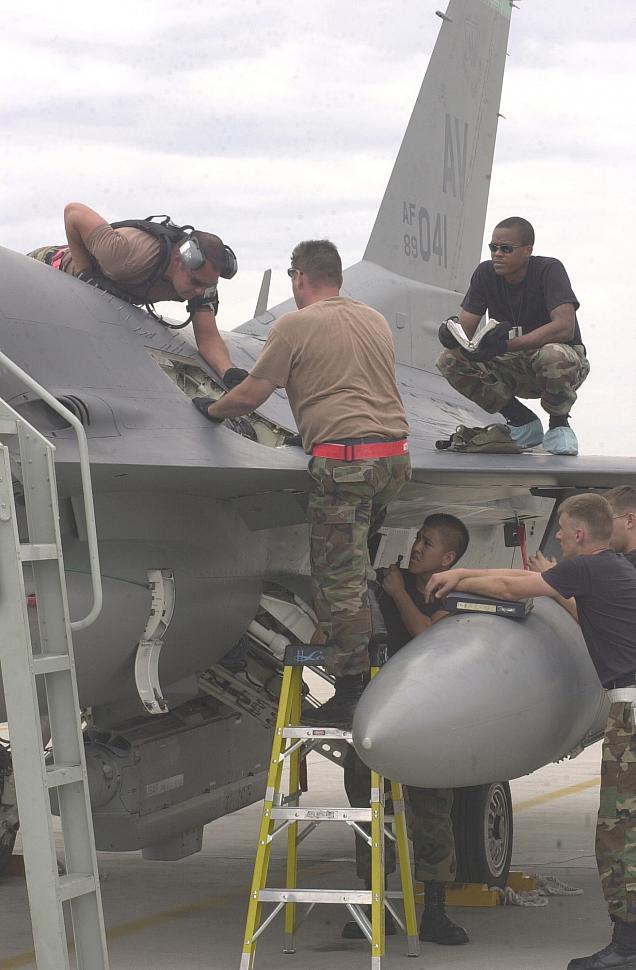
F-16.net: Please give us an overview of your military career and tell the readers a little about yourself?
John: I joined the USAF in May 2003 for six years with the guaranteed job of a fighter aircraft crew chief. I had the possibility of being assigned to the F-15C/D/E, A-10A, U-2S, F-16C/D, or F-117A. I wound up getting a slot for the F-16 and was assigned to the 555th FS at Aviano AB, Italy. I have always been an aviation nut, and the Viper's always been my favorite jet. I'm an F/A-18 fan as well, but never seriously considered the Navy for my service.
F-16.net: How did your military career start?
John: I signed onto the DEP (Delayed Enlistment Program, or "waiting list") for my job January 2003 in Austin, Texas, and reported to Basic Training (San Antonio, Texas) in May. At the time, there was an enlistment bonus for my career field, which has since been reduced and/or removed.
F-16.net: After joining the USAF where did they send you? And what training did the USAF put you through?
John: After six and a half weeks of Basic Training in San Antonio, I was sent to Sheppard AFB in Wichita Falls, Texas for technical training. Although it is the most enjoyable part of USAF training, college it is not. On a 1-to-10 scale of how controlled an environment it is, I would call Basic Training 10/10 and technical scool 8/10, which gradually reduces until you graduate as you get more privileges. As with Basic the first week or so is hard until you settle in. But there's little or no bullying or such by students who've been there longer than you. The only friction between students is due to the different airframes they train on (i.e. "Go A-10!" or "Go F-16!"), but it is always comedic in nature. Despite many "distractions" in Wichita Falls (bars, strip clubs, etc.), it pays to be a "dorm rat" studying for your time there, as it's almost guaranteed that your off-duty activities will come through in your grades.
After about six-and-a-half months at Sheppard, I was sent with my class (which remained more or less intact) to Luke AFB in Phoenix for the HOT (hands-on training) portion. Luke is a blast. They house eight fighter squadrons and over 200 F-16s, ranging from Blocks 25, 32, and 42, to ROSAF (Singapore) block 52 F-16Ds with dorsal spines. The base facilities are excellent, and Phoenix is an incredible city. I really do have to go back someday! My objectives at Luke were to learn to launch, recover, and refuel the F-16, along with some other servicing that could not be done on "static" aircraft at Sheppard. Upon completion, after about 5 weeks, you're declared a Mission-Ready Airman. I'd like to add that there are awards for good grades and a class-leading "Distinguished Graduate" award at both bases. I earned DG at Sheppard and nearly again at Luke. These awards follow you to your first duty assignment.
F-16.net: How many people are trained at the same time/in class?
John: It's changed a few times, but the numbers generally decrease as you shift from general ("Fundies" or "Commons" classes) to more specific training, and then to HOT training. This is mainly to help the instructors focus more of their attention on individual students. A typical "Flight" in Basic Traning consists of about 60 trainees. My fundies class drew about 20 airmen, my F-16 class had eight, and HOT training had eight with two instructors.
F-16.net: What is the pass ratio?
John: I'm not sure percentage-wise, but it's pretty high. The squadron leaders and instructors are pretty good at initially weeding out those who'd rather be somewhere else (in the USAF, that is), so the students they wind up with are pretty sharp. I have seen some failures and some "reclasses", but it's nothing to discourage. If you're committed, you'll do alright.
F-16.net: When did you first actually work on a real F-16?
John: Once your classes start, it's mostly paperwork and book-based for the first couple weeks. The F-16 classes are laid out so that you learn a system or two at a time (i.e. hydraulic and electric, or landing gear and flight controls) in the books first, then experience it on the actual aircraft. This cycle continues (books, jet, books, jet) until you've covered everything. There's also usually a week or so at the end of Sheppard training for anything further to be discussed or reviewed. It's also an opportunity to have some celebratory pizza with your instructor!
F-16.net: What was the big difference between training and being operational?
John: What you do matters, and you see the results every day at the end of your shift. It's also a big responsibility to be assigned to a jet, even as an assistant, and you take pride in that extra effort and personal touch.
F-16.net: What type of continuing education is required?
John: It's been said "if your Air Force career spanned twenty years, you'd still be training on your retirement date." Training is continuous and intense. For example, right now, while fixing jets, I'm training to advance to the Journeyman level of my job. The training is almost entirely book-based, very technical (more in-depth with the aircraft systems), and the time to complete it is limited. The advantage here is that I am working on jets all day, and it's much easier to get hands-on with what I'm studying. I must also get certified to complete around 80 new maintenance tasks required to advance in skill level. Once I'm done, and later when I earn the rank of Staff Sergeant, it all starts again! If you consider learning fun, you'll love the Air Force.
F-16.net: What is your most memorable time out on the ramp working on the F-16 both positive and/or negative?
John: My "baptism of fire" as it were, my first day working the line at Aviano, is the most memorable so far. I immediately became close with other crew chiefs, and was able to see what being one really means. I also always remember my "finds" - times when I discover something amiss during an inspection or when just looking the aircraft over. Each one reflects positively on a crew chief, especially if it is repaired with no delay in the flying schedule.
F-16.net: You mentioned "finds" being a positive reflection on a crew chief. What is the best "find" in your opinion?
John: Anything and everything. Specific emphasis is placed on any find that would have resulted in loss of aircraft, life, or both. As they say, "that's a bullet!
F-16.net: What is the hardest thing about working on the F-16?
John: De-paneling and re-paneling the jet. It's very frustrating to spend 30 minutes with a speed handle to remove panels from the engine area, when most other jets (F-15, F/A-18, F/A-22) use dzus fasteners for the major panels that can be opened in seconds. The best thing about working on the Viper is the simplicity of the single-engine design. One engine, one gearbox, one starting system. After seeing transient F-15Es here for exercises, and after reuniting with some buddies from tech school who crew the A-10, I know firsthand that the Viper is the best in the Air Force.
F-16.net: Any fond memories of a specific deployment or exercise?
John: Only exercises thus far, but doing quick combat turnarounds during one exercise was fun. It's very fast paced. It was also very memorable to see the entire Nickel fleet return from a recent deployment. Catching my dirty, overworked, sand-filled jet was a nice feeling to have again.
F-16.net: What assignment/squadron was your favorite?

John: 555th AMU "Triple Nickel" is the only squadron I've worked so far, but I love the feeling of family that exists. I've developed some very close ties with a lot of folks here.
F-16.net: What is squadron life like with the 555th FS now that hostilities have settled in Bosnia?
John: We have been involved in both Operations Enduring Freedom and Iraqi Freedom along with the 510th FS here, but I cannot elaborate about when and where. We're very actively involved, though.
F-16.net: Do the old timer crews talk about how tough it used to be during the war?
John: A few chiefs here were in Desert Shield/Storm, and the ones in the recent OEF and OIF deployments always have stories to tell, and are quick to tell new airmen how "educational" one's first deployment is.
F-16.net: Is there any particular F-16 tail number(s) to which you are fond?
John: F-16CG #89-2038 is my bird right now, but I still remember #83-1131, the very first jet I crewed at Luke.
F-16.net: What unit were you with at Luke and any fond memories of that squadron or Luke AFB?
John: I was working for the 309th "Wild Ducks," and my class was presented with "thank you" certificates for our assistance, as they had many of their maintenance personel deployed at the time.
F-16.net: What is the best/worst practical joke you played on a victim(s)?
John: Aside from "hot exhaust samples," I was in on a "Code 6 for an unsecured panel" squawk on another FNG here, who completely fell for it. He was convinced he was in big trouble, and gave us in the truck a good laugh!

F-16.net: What advice would you give junior ground crew?
John: As opposed to technical training, the emphasis on the line is more on watching and doing than reading. Always be aware of the tasks you're unfamiliar with, ask to help, and make known your thirst for knowledge. Remember that rank does not necessarily mean experience.
F-16.net: Any words of advice to any of our young readers wanting to join the military?
John: I waited until I was 25 mostly due to jobs that got me nowhere, and I realized mere hours into Basic Training that I should have done this long ago! So my message is to not wait!
F-16.net: What sparked your interest in aviation?
John: It's hard to say; I've been into aviation for as long as I can remember. I guess the difference is that I never lost interest, and kept building scale models and hitting up the airshows. I never did have too much drive to get a pilot's license, though.
F-16.net: Anything you want to add? Anything you would like to say to your fellow aviation fans?
John: This is a very special career field in the USAF. Though the hours are long and the work is hard, a close feeling of family develops among the maintainers, and there is nothing in the world like seeing your jet break ground or coming back from EOR after a mission. And I've never seen anybody make a "you might be in the Comm Squadron if..." list!
F-16.net: Thank you for the interview!
- A1C John Wilson was interviewed online by Jon Somerville in April of 2004.
Note: Errors and omissions in the above text can be added here. Please note: your comments will be displayed immediately on this page.
If you wish to send a private comment to the webmasters, please use the Contact Us link.


